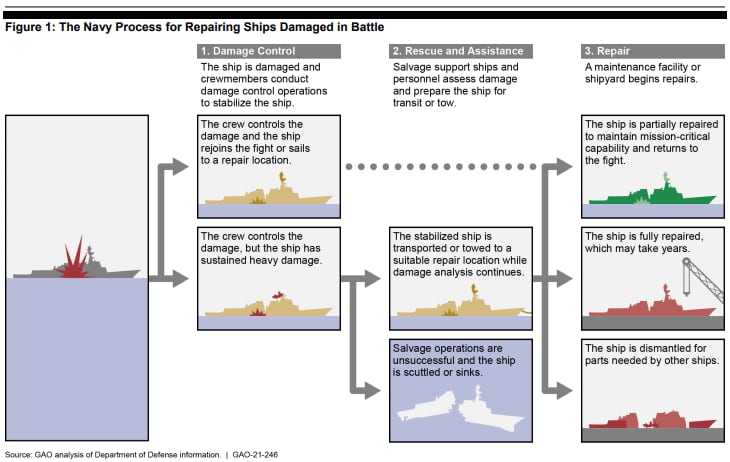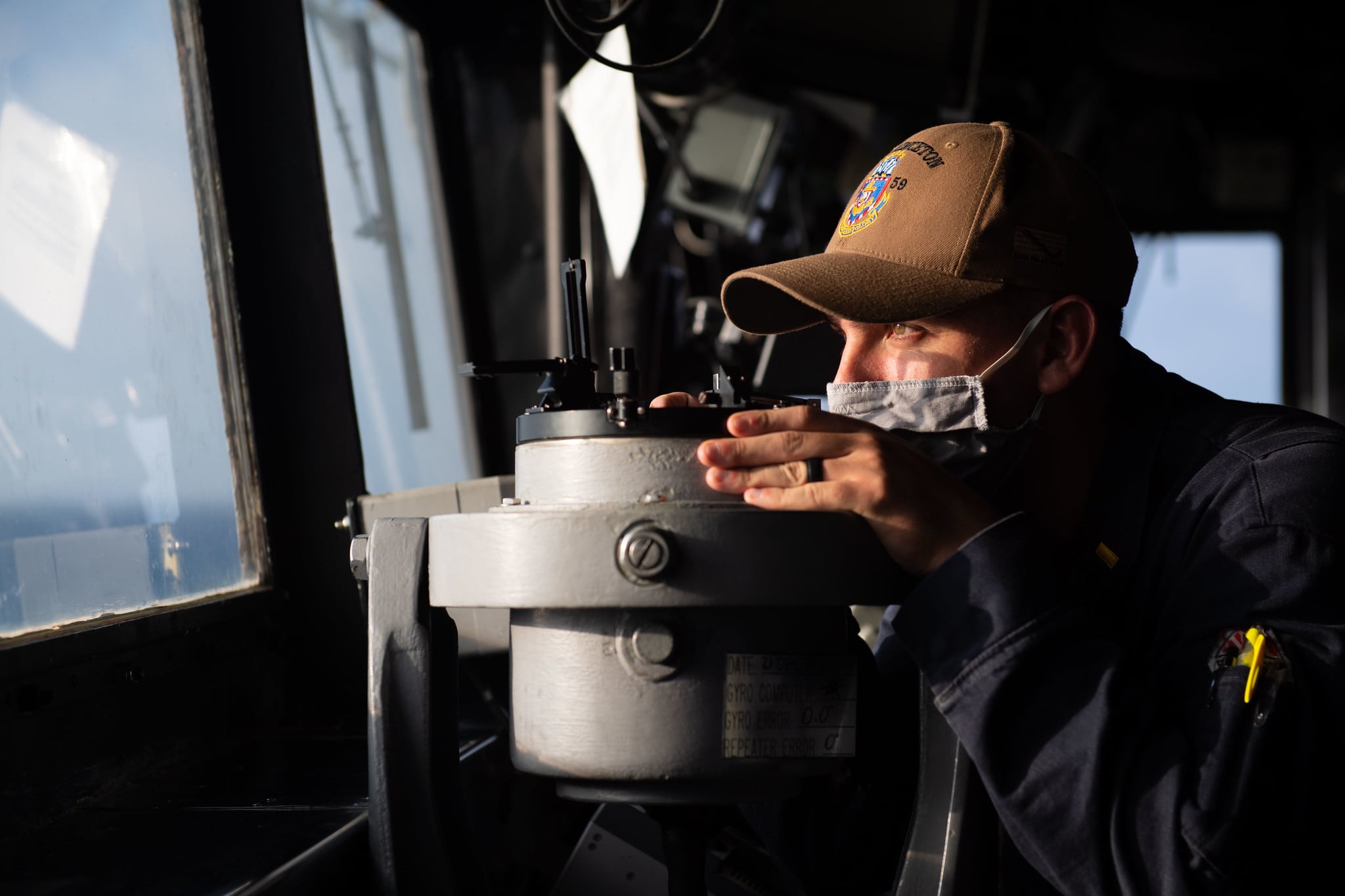As U.S. Navy brass continues to sound the alarm about a future war with China, or at least the end of American naval dominance in the Pacific, a new government watchdog report questions whether the sea service would have the ability to repair battle-damaged ships should a conflict break out.
The Navy divested many of its wartime ship repair capabilities following the Cold War, last week’s Government Accountability Office report states.
“With the rise of great power competitors capable of producing high-end threats in warfare, the Navy must now be prepared to quickly salvage and repair damage to a modern fleet,” the report states.
GAO investigators assessed the challenges the Navy would have in using its regular maintenance capability to repair battle damage and also evaluated whether the Navy has begun to develop such a repair capability.
The Navy itself has identified several challenges in using its regular maintenance systems — which restore ships to full operational status — should battle damage repairs be required in war, according to the GAO.
But the Navy lacks “established doctrine for battle damage repair, unclear command and control roles and a shortage of repair capacity,” the report states.

Although the sea service is in the early stages of sussing out how it will provide battle damage repair at war, the Navy has not designated a lead for these plans, according to GAO.
“Without designated leadership, the Navy may be hindered in its efforts to address the many challenges it faces in sustaining its ships during a great power conflict,” the report states.
And while the Navy develops ship vulnerability models during acquisition that estimate damage factors during war, such models are not sufficiently updated during a vessel’s decades of service.
“Without periodically assessing and updating its models to accurately reflect the ship’s mission-critical systems, the Navy has limited its ability to assess and develop battle damage repair capabilities necessary to sustain ships in a conflict with a great power competitor,” the GAO warns.
The 2020 National Defense Authorization Act called for the GAO to study the Navy’s ability to conduct battle damage repair.
The Navy hasn’t had to conduct battle damage repair since World War II and would now need to repair ships with far more intricate electrical, radar and computer systems while doing so without as many public shipyards or tenders, GAO notes.
GAO has in recent years filed several reports warning of the Navy’s challenges when conducting peacetime maintenance and getting ships out of the yards in time when no all-out war is occurring.
“In light of ongoing shipyard challenges to keep up with regular maintenance demand, battle damage repairs may further exacerbate these challenges, the latest report notes.
While any battle damage efforts would lean on the Navy’s conventional maintenance capability, such plans could be affected by repairs having to be conducted in a combat zone, where repair capabilities could be at risk of further attack.
Time constraints — the need to get such ships back into the fight as fast as possible — as well as multiple ships requiring repair, would further complicate such efforts, according to the GAO.
Depending on the nature and location of the conflict, repair resources and replacement warships might not be readily available, either, the report states.
At the same time, the Navy is in the early stages of developing battle damage repair concepts, which could lead to updated requirements, according to the GAO.
U.S. Pacific Fleet began developing the “Ship Wartime Repair and Maintenance” concept in 2019 and finalized it in April, laying out the people, parts and processes required to provide in-theater ship and submarine repair.
U.S. Fleet Forces Command is developing the “Expeditionary At-Sea Repair” concept, and is expected to be completed next fiscal year, according to the GAO.
But while the sea service has 15 battle damage repair efforts in the works, eight of them “are in early development stages,” the report states.
At this stage, the Navy also lacks the command-and-control guidance that would be needed should a warship require urgent battle-damage repair.
RELATED

“Navy officials we spoke with generally noted a lack of clarity in the decision-making process, such as who within the chain of command decides whether to rearm or repair a damaged ship,” the report states.
Among GAO’s recommendations, the watchdog contends that Navy leadership needs to designate an organization to lead battle damage repair efforts while regularly assessing and updating ship vulnerability models, while also issuing guidance clarifying command and control responsibilities for battle damage repair efforts.
“The Navy partially concurred with these recommendations, which GAO continues to believe are warranted,” the report states.
In its response, the Navy stated that Naval Sea Systems Command is the organization with the authority to oversee and lead development of battle damage repair capability, although NAVSEA is not officially designed to perform these roles, despites studies showing that an official designation would be helpful.
The Navy’s response also noted that NAVSEA has command-and-control responsibilities for battle damage, but that it is not officially designed for such a role.
The GAO report states that such an official designation would help clarify things as Navy officials interviewed by the watchdog “noted a lack of clarity in the decision-making progress.”
While GAO recommended that the Navy establish guidance that would periodically assess and update ship vulnerability models to inform the battle damage repair effort, the sea service noted that NAVSEA determines how frequently such updates occur.
“We agree with the Navy’s commitment to updating ship vulnerability models,” the report states. “However, we continue to believe the frequency and factors requiring those updates should be established in guidance, to ensure the Navy is systematically updating models after it acquires ships.”
Rory O’Connor, a NAVSEA spokesman, said in an email to Navy Times that while the department appreciates independent assessments, it does not feel that formal designations for overseeing battle damage repair is necessary since NAVSEA “already has the authority to lead and oversee development.”
He added that NAVSEA officials will continue determining how often to update vulnerability models “to better support battle damage repair.”
Geoff is the managing editor of Military Times, but he still loves writing stories. He covered Iraq and Afghanistan extensively and was a reporter at the Chicago Tribune. He welcomes any and all kinds of tips at geoffz@militarytimes.com.




